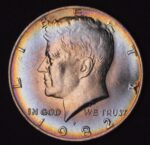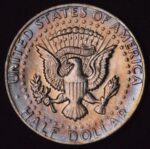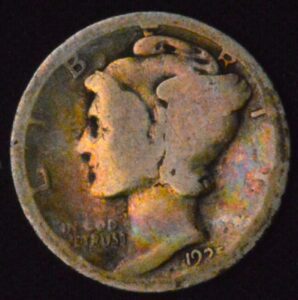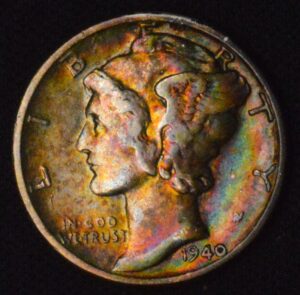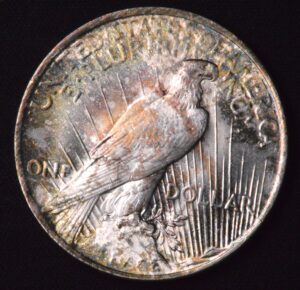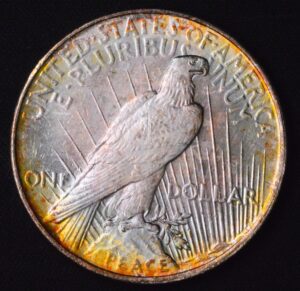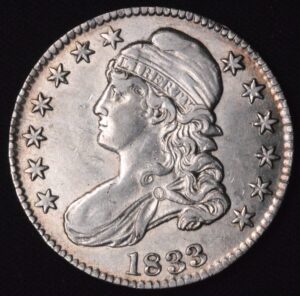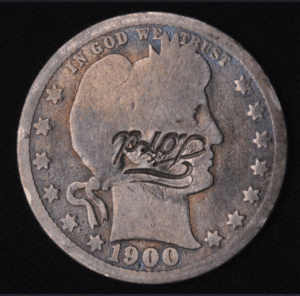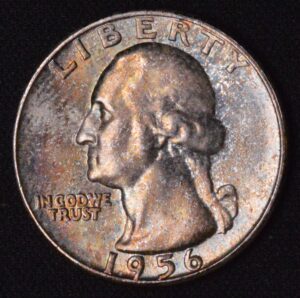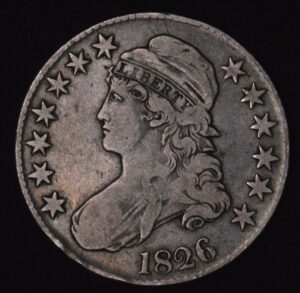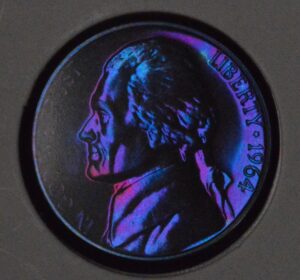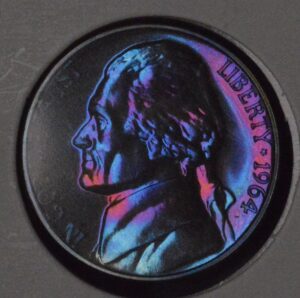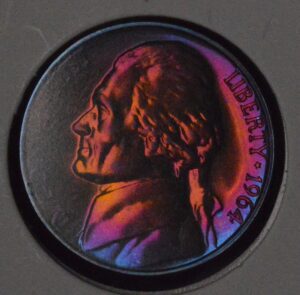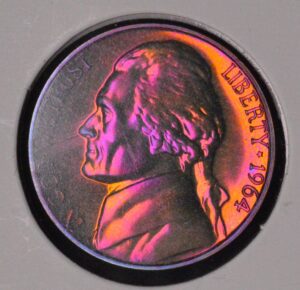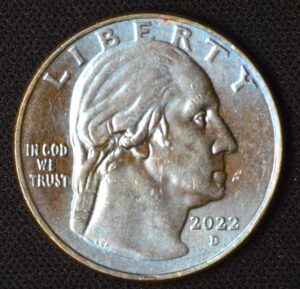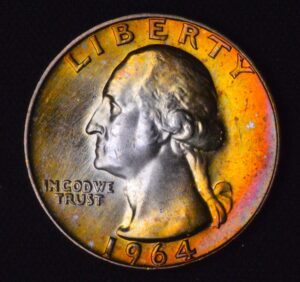Description
The 1982 Kennedy Half Dollar is struck in a copper-nickel clad composition, consisting of 75% copper and 25% nickel outer layers bonded to a pure copper core. This composition has been used for circulating Kennedy halves since 1971, marking a departure from the earlier silver content in the coin series. The coin weighs approximately 11.34 grams and measures 30.61 mm in diameter, featuring the classic portrait of President John F. Kennedy on the obverse by Gilroy Roberts, and the Presidential Seal on the reverse by Frank Gasparro.
A pastel or rainbow toned 1982 Kennedy Half Dollar refers to a coin that has developed natural coloration due to chemical reactions between the metal surfaces and environmental elements over time. These colors can include soft shades of blue, pink, purple, and yellow, creating an attractive and unique appearance that enhances collector interest. Such toning is highly regarded when it appears evenly distributed and enhances the coin’s visual appeal without detracting from the sharpness of the design.
While the 1982 Kennedy Half Dollar is a common coin with a large mintage from both Philadelphia and Denver mints (over 13 million for Denver alone), well-struck examples with pleasing pastel rainbow toning can command premiums above the typical market value. Uncirculated examples with eye-catching natural toning may sell for between $10 and $50 or more, depending on condition and the intensity or appeal of the toning.
Professional grading and certification often help validate the toning’s authenticity and the coin’s grade, adding confidence for buyers and sellers. Graded coins with attractive pastel toning in MS63 or higher grades are particularly desirable. Collectors who appreciate variety and aesthetics in modern coinage prize these toned examples as a way to elevate a common date’s value and beauty.
In summary, the 1982 Kennedy Half Dollar clad pastel rainbow toned coin combines the enduring appeal of the Kennedy design with natural, attractive toning. Its value reflects both its condition and the desirability of the toning, making it a standout piece among typical circulation strikes from this era.
The 1982 Kennedy Half Dollar is struck in a copper-nickel clad composition, consisting of 75% copper and 25% nickel outer layers bonded to a pure copper core. This composition has been used for circulating Kennedy halves since 1971, marking a departure from the earlier silver content in the coin series. The coin weighs approximately 11.34 grams and measures 30.61 mm in diameter, featuring the classic portrait of President John F. Kennedy on the obverse by Gilroy Roberts, and the Presidential Seal on the reverse by Frank Gasparro.
A pastel or rainbow toned 1982 Kennedy Half Dollar refers to a coin that has developed natural coloration due to chemical reactions between the metal surfaces and environmental elements over time. These colors can include soft shades of blue, pink, purple, and yellow, creating an attractive and unique appearance that enhances collector interest. Such toning is highly regarded when it appears evenly distributed and enhances the coin’s visual appeal without detracting from the sharpness of the design.
While the 1982 Kennedy Half Dollar is a common coin with a large mintage from both Philadelphia and Denver mints (over 13 million for Denver alone), well-struck examples with pleasing pastel rainbow toning can command premiums above the typical market value. Uncirculated examples with eye-catching natural toning may sell for between $10 and $50 or more, depending on condition and the intensity or appeal of the toning.
Professional grading and certification often help validate the toning’s authenticity and the coin’s grade, adding confidence for buyers and sellers. Graded coins with attractive pastel toning in MS63 or higher grades are particularly desirable. Collectors who appreciate variety and aesthetics in modern coinage prize these toned examples as a way to elevate a common date’s value and beauty.
In summary, the 1982 Kennedy Half Dollar clad pastel rainbow toned coin combines the enduring appeal of the Kennedy design with natural, attractive toning. Its value reflects both its condition and the desirability of the toning, making it a standout piece among typical circulation strikes from this era.
The 1982 Kennedy Half Dollar is struck in a copper-nickel clad composition, consisting of 75% copper and 25% nickel outer layers bonded to a pure copper core. This composition has been used for circulating Kennedy halves since 1971, marking a departure from the earlier silver content in the coin series. The coin weighs approximately 11.34 grams and measures 30.61 mm in diameter, featuring the classic portrait of President John F. Kennedy on the obverse by Gilroy Roberts, and the Presidential Seal on the reverse by Frank Gasparro.
A pastel or rainbow toned 1982 Kennedy Half Dollar refers to a coin that has developed natural coloration due to chemical reactions between the metal surfaces and environmental elements over time. These colors can include soft shades of blue, pink, purple, and yellow, creating an attractive and unique appearance that enhances collector interest. Such toning is highly regarded when it appears evenly distributed and enhances the coin’s visual appeal without detracting from the sharpness of the design.
While the 1982 Kennedy Half Dollar is a common coin with a large mintage from both Philadelphia and Denver mints (over 13 million for Denver alone), well-struck examples with pleasing pastel rainbow toning can command premiums above the typical market value. Uncirculated examples with eye-catching natural toning may sell for between $10 and $50 or more, depending on condition and the intensity or appeal of the toning.
Professional grading and certification often help validate the toning’s authenticity and the coin’s grade, adding confidence for buyers and sellers. Graded coins with attractive pastel toning in MS63 or higher grades are particularly desirable. Collectors who appreciate variety and aesthetics in modern coinage prize these toned examples as a way to elevate a common date’s value and beauty.
In summary, the 1982 Kennedy Half Dollar clad pastel rainbow toned coin combines the enduring appeal of the Kennedy design with natural, attractive toning. Its value reflects both its condition and the desirability of the toning, making it a standout piece among typical circulation strikes from this era.
CUSTOMER FEEDBACK








Related Products & Newly Released!




SHIPPING POLICY
Your order is shipped from the United States with USPS tracking within one business day.
14 Day Return Policy
You can return your item back within
14 days of the purchase

Secure payments
Your payments are 100% secure and are processed through Square or PayPal on a protected security network.
SHIPPING POLICY
FREE International and Domestic (United States) shipping. Your order is shipped with USPS tracking 24 hours after you order.
14 Day Return Policy
You can return your item back within
14 days of the purchase

Secure payments
Your payments are 100% secure and are processed through Square or PayPal on a protected security network.
RESOURCES
support
Get Real Deals!
Sign up now to receive our articles for the latest insights and promotions!
RESOURCES
support
Get Fresh Articles!
Signup our newsletter to get update insight or promotions.




